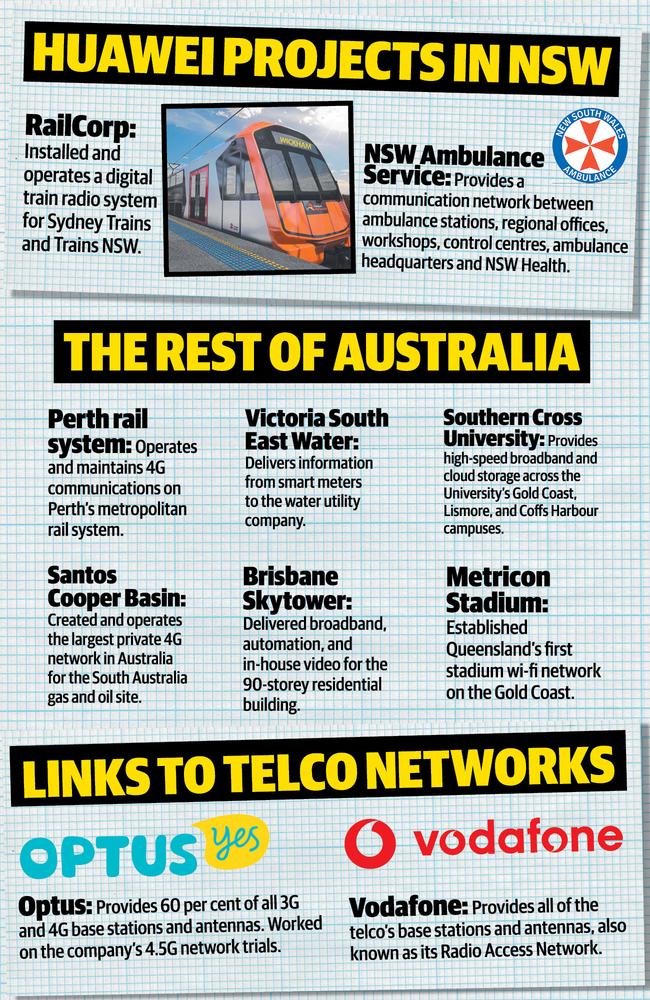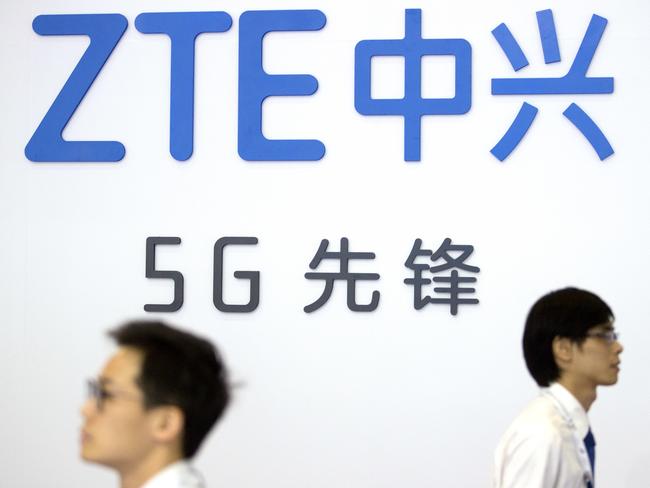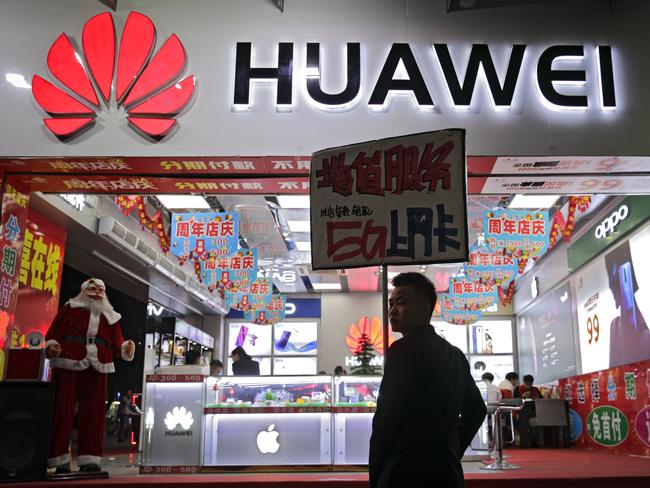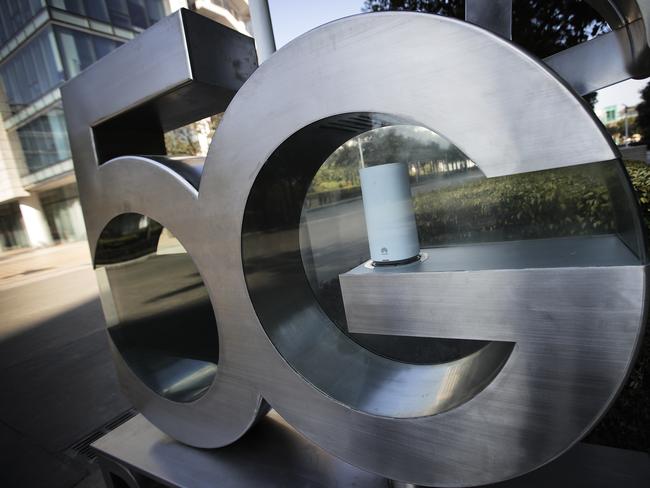Huawei national security risk: Why China’s tech giant is facing an enormous international backlash
Technology giant Huawei is so deeply embedded in Australia’s critical infrastructure the Chinese agency could bring the country to its knees in the event of a conflict.
Technology giant and suspected Chinese-government spy enterprise Huawei is so deeply embedded in Australia’s critical infrastructure and mobile networks it could bring the country to its knees in the event of a conflict.
Huawei carries crucial data for NSW and WA railways, along with ambulance services, universities and mining projects — as well as half the smartphone calls, texts, and internet usage in Australia on any day.
With Huawei believed by Australia and key allies to harvest information for the Communist Party of China, Telstra has stopped selling its smartphones and Defence has phased out smartphones made by Huawei and fellow Chinese manufacturer ZTE due to security concerns.
In order to cull its dominance and to stop granting China backdoor access, the federal government has banned Huawei — “wah-way” — from participating in the 5G network, which rolls out in 2020.
But Fergus Hanson, head of cyber policy at the Australian Security Policy Institute, says Huawei is already entrenched in our infrastructure.

“Having sold the product, if they have inserted vulnerabilities, and if they know how the networks are set up, they’re easier to take down,” Mr Hanson said.
Huawei installed upgraded technology to NSW RailCorp’s entire electrified network, which controls signalling, shunting and communications between crews. Just before the 5G ban was announced in August, the WA Government announced Huawei had won a contract for similar upgrades to its rail.
In Brisbane, the soon-to-be-completed luxury 90-storey Skytower will rely on Huawei for its smart technology fit-out, potentially exposing residents to risk.
SPECIAL REPORT: How China is building the perfect dystopia
Earlier this year, Le Monde reported that massive data dumps were occurring from the African Union’s skyscraper headquarters in Addis Ababa each night between midnight and 2am, and heading to Shanghai.
Danielle Cave, from ASPI’s cyber centre, wrote that it was not reported at the time which carrier had moved the stolen information. “It was Huawei,” she said.
As China signals more aggressive intent globally, there are persistent claims that Huawei, its flagship worldwide communications success story, has engineered a “kill switch” which could instantly plunge its networks into darkness.
Its existence has been denied by Huawei and it is thought improbable.
But it is suspected China, through Huawei, has already been granted an intimate look at our most critical infrastructure and has done the same in 170 other countries where it operates.
As Australia’s largest telecommunications technology supplier, Huawei provides 60 per cent of all Optus base stations and antennas for its 3G and 4G mobile network and delivers 100 per cent of Vodafone’s base stations and antennas.
SPECIAL REPORT: Aussie defence chief warns we’re ‘sleepwalking’ into war
Optus and Vodafone are the second and third biggest national carriers respectively.
Mr Hanson said owning a Huawei phone was not the problem — even though Defence departments in Australia and the US have banned them.
“It’s the network,” he said. “It’s about hospitals, electricity, gas networks, solar grids — everything.”
Japan this week banned Huawei and ZTE from competing for official contracts, which follows Britain’s largest mobile phone provider, BT Group, removing Huawei equipment from its 4G and 3G networks — and the UK is putting Huawei under heavy scrutiny as 5G approaches.
New Zealand has banned Huawei products in Spark’s 5G network and India blocked it from its 5G trials.

Huawei denies links to China’s People’s Liberation Army and its Australian chairman, former Royal Australian Navy rear-admiral John Lord, along with director and former Victorian premier John Brumby, have been running an intense PR campaign arguing Huawei is “good and safe” for Australia.
A company representative told News Corp Mr Lord was no longer doing interviews after spending most of the year trying to persuade the federal government that Huawei presented no risk.
Clive Hamilton, author of Silent Invasion, on the growing influence of China in Australia, disagreed and said Mr Lord and Mr Brumby were wrong to claim it was a “myth” that Huawei was benign.
“Huawei is now being rejected around the western world because of the serious risk of espionage.”
Huawei has offered its equipment for inspection and in the UK, where Huawei is a major supplier of critical infrastructure, there is a government lab that solely studies Huawei products for Trojan Horses. It even files an annual report.
This year, it reported that “shortcomings in Huawei’s engineering processes have exposed new risks in the UK telecommunication networks”.
MORE: Huawei’s message to Australia
Mr Hanson said this referred to software “errors” and vulnerabilities that might be deliberate placed to allow remote access. “You basically try to make a call whether they inserted them on purpose or is it a coding error,” he said.
In 2017, the CPC passed a law requiring any state-owned company to carry out any instruction given by the state. Said Mr Hanson: “If the Ministry of State Security says to Huawei, ‘We want you to intercept communications in Australia,’ they are obliged to do it.”
Mr Lord has argued, to deaf ears, that Huawei is an independently owned company, free of the clutches of the CPC. A number of western nations see otherwise and this has been bolstered by China’s outrage at the arrest of Huawei chief financial officer Meng Wanzhou.
Ms Wanzhou was detained in Canada at the request of the US Justice Department on suspicion she had used a Huawei subsidiary to evade sanctions with Iran.
Mr Hanson warned China was not the mercantile coloniser of times past.
“We work under the old assumption China would rise peacefully, and it’s turned the other way,” he said. “You can’t walk away from Chinese technology, but you can gradually wind back on the critical and sensitive areas.”

HUAWEI PROJECTS IN AUSTRALIA
Optus: Provides 60 per cent of all 3G and 4G base stations and antennas. Worked on the company’s 4.5G network trials.
Vodafone: Provides all of the telco’s base stations and antennas, also known as its Radio Access Network.
Perth rail system: Operates and maintains 4G communications on Perth’s metropolitan rail system.
RailCorp: Installed and operates a digital train radio system for Sydney Trains and Trains NSW.
NSW Ambulance Service: Provides a communication network between ambulance stations, regional offices, workshops, control centres, ambulance headquarters and NSW Health.
Victoria South East Water: Delivers information from smart meters to the water utility company.
Southern Cross University: Provides high-speed broadband and cloud storage across the University’s Gold Coast, Lismore, and Coffs Harbour campuses.
Santos Cooper Basin: Created and operates the largest private 4G network in Australia for the South Australia gas and oil site.
Brisbane Skytower: Delivered broadband, automation, and in-house video for the 90-storey residential building.
Metricon Stadium: Established Queensland’s first stadium wi-fi network on the Gold Coast.

HUAWEI’S WORLDWIDE BANS
December 10, 2018: The Japan government banned Huawei and ZTE from competing for official contracts in the country, and Japan’s three most popular telcos followed its lead.
December 5, 2018: Britain’s largest mobile phone provider, BT Group, removed Huawei equipment from its 4G and 3G networks and said it would not use the company’s products in the central part of its 5G network.
November 27, 2018: New Zealand’s Government Communications Security Bureau banned the use of Huawei products in Spark’s 5G network.
August 23, 2018: PM Scott Morrison banned Chinese providers Huawei and ZTE from involvement in the 5G network in Australia to begin on September 18.
August 13, 2018: Huawei and ZTE were banned from use by US government and government contracts under the Defense Authorization Act.
May 10, 2018: Telstra issued a “stop-sell” on smartphones and devices from fellow Chinese firm ZTE. The company has also quietly stopped selling Huawei smartphones, including its flagship Mate 20 Pro phone.
May 2, 2018: The Pentagon issued a ban on selling Huawei and ZTE smartphones on US
military bases.
February 28, 2018: Australia’s Defence Department phased out use of Huawei and ZTE smartphones due to potential security concerns.
March 26, 2018: Labor banned Huawei from tendering for contracts for the NBN.
WHO IS HUAWEI?
IT’S the world’s second biggest smartphone maker, the largest telecommunications equipment provider and its name, while hard to pronounce, can be translated to “China is able”.
Huawei is also the subject of worldwide scrutiny, following further bans on its equipment, the arrest of Huawei chief financial officer Meng Wanzhou in Canada, and the subsequent detainment of three Canadians in China.
But Huawei was perhaps always controversial or, at least, unusual. The company was founded by former People’s Liberation Army engineer, Ren Zhengfei, in 1987.
Its breakthrough came in 1993 when it released its own telephone switch that it began installing in China, even paying local authorities to use Huawei equipment.
The company later built the first telecommunications network for the People’s Liberation Army and, in 1996, benefited from Chinese restrictions on foreign telecommunications operators.
Huawei is not owned by the Chinese government, however, and its shares are distributed between its founder and the company’s Chinese employees.
It currently operates 170 countries and, according to research firm IDC, shipped 54.2 million mobile phones between June and August this year to overtake Apple and become the world’s second biggest smartphone maker.
Originally published as Huawei national security risk: Why China’s tech giant is facing an enormous international backlash


